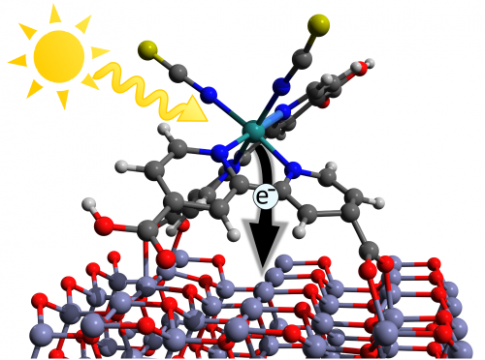Riddle of missing efficiency in zinc oxide-based dye-sensitised solar cells solved

Illustration of the initial charge transfer step in a dye sensitized solar cell. A photon from the sun is absorbed and excites the dye molecule. Subsequently, an electron can is injected into the ZnO-Layer where it can be trapped by so called interface-states. Credit: Mario Borgwardt/HZB
To convert solar energy into electricity or solar fuels, you need specialised systems of materials such as those consisting of organic and inorganic thin films. Processes at the junction of these films play a decisive role in converting the solar energy. Now a team at HZB headed by Prof. Emad Aziz has used ultra-short laser pulses and observed for the first time directly how boundary states form between the organic dye molecules and a zinc-oxide semiconductor layer, temporarily trapping the charge carriers. This explains why zinc-oxide (ZnO) dye-sensitised solar cells have not yet met expectations. The results evolved from collaboration between Monash University (Australia) and Joint Lab partners Helmholtz Zentrum Berlin (HZB) and the Freie Universität Berlin (FU Berlin). They have now been published online by Nature in the open access magazine Scientific Reports.
Converting the energy of the sun into electricity and solar hydrogen can be achieved with a whole series of materials. One important class of organic solar cells uses dyes applied to a semiconductor material like titanium dioxide (TiO2), for example. The dye molecules function as a kind of "translator" for the solar energy. They capture the light and inject electrons as free charges carriers into the TiO2 resulting in current flow. However, TiO2 is far from ideal and zinc oxide (ZnO) should actually be more suitable as an electrode material. This is because the charge carriers are far more mobile in ZnO, so they should flow more quickly after charge separation has occurred. In addition, nanostructures that capture sunlight especially efficiently can be produced in simple fashion using ZnO.
Detailed investigation of excited states with ultrashort Laser pulses
Nevertheless, constructing ZnO solar cells that better those of TiO2 had not been accomplished thus far. Now a team headed by Emad Aziz has for the first time directly observed the cause for this and investigated it in detail at the "Joint Ultrafast Dynamics Lab in Solutions and at Interfaces". The Joint Lab is being operated by HZB together with FU Berlin. It has a complete array of state-of-the-art laser instruments at its disposal, including a time-resolved photoelectron spectrometer that can generate ultra-short XUV pulses with duration below 45 femtoseconds. These ultra-short light pulses enable the temporal as well as energetic development of excited states to be tracked on ultra-short timescales.
Interface states as traps for charge carriers
"Our measurements show directly for the first time that charge carriers are temporarily trapped by formation of an interface state between the dye and the semiconductor boundary layer. As a result, they are no longer immediately available as free charge carriers", explains Mario Borgwardt, doctoral student on Aziz' team. These "trapped" electrons within the interface stay put longer. This increases the probability that they are "lost" again through recombination. That in turn reduces the efficiency level of the solar cell.
The samples for the experiment were made available by Prof. Leone Spiccia's team from Monash University, Australia. A fruitful collaboration evolved in the course of Spiccia's visit last year as part of his Helmholtz International Fellowship award from the Helmholtz Association that has contributed in a fundamental manner to the success of this project.
Helpful hints for the design of materials for energy conversion or storage
Aziz explains the importance of the results: "The work has led to a better understanding of the processes at the boundary layer between dye molecule and semiconductor. We have therefore been able to understand how dye and semiconductor materials communicate with one another. This enables us now to devise approaches for improving the communication in a direct way. That is important not only for the design of dye-sensitised solar cells, but also in order to be able to develop systems of materials for photocatalytic generation of hydrogen for storing solar energy as hydrogen fuel."


































